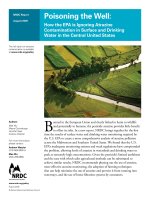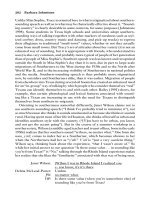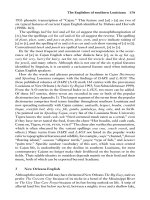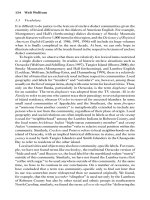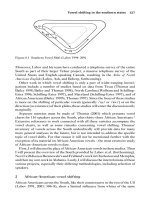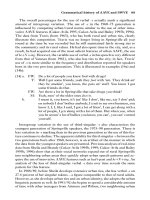English in the Southern United States phần 1 pps
Bạn đang xem bản rút gọn của tài liệu. Xem và tải ngay bản đầy đủ của tài liệu tại đây (589.79 KB, 27 trang )
English in the Southern United States
The English of the southern United States is possibly the most studied
regional variety of any language because of its rich internal diversity, its dis-
tinctiveness among regional varieties in the United States, its significance
as a marker of regional identity, and the general folkloric appeal of southern
culture. Ho
wever, most if not all books
about Southern American English
have been directed almost exclusively toward scholars already working in
the field. This volume, written by a team of experts many of whom are in-
ternationally known, provides a broad overview of the foundations of, and
current research on, language variation in the southern United States de-
signed to invite new inquiry and inquirers. It explores historical and cultural
elements, iconic contemporary features, and current changes in progress.
Central themes
, issues,and topics of scholarly
investigatio
nandde
bate figure
prominently throughout the volume. The extensive bibliography at the end
of the book will facilitate continued research.
. is Professor of English at Coastal Carolina Univer-
sity. He is the author of Inferential Change and Syntactic Modality in English
(1989), editor of a monograph on political changes in eastern Europe (1992),
and the author or co-author of articles on English historical syntax, auxiliary
verbs in southern English, and teaching English as a second language.
. is Professor of English at Coastal Carolina University.
She is the author or co-author of articles related to language use, language
learning, and language diversity. She was the compositor of the Linguistic
Atlas of the Middle and South
Atlantic States
(LAMSAS) for three years.
Editorial Board
Bas Aarts, John Algeo, Susan Fitzmaurice,
Richard Hogg, Merja Kyt
¨
o, Charles Meyer
English in the Southern United States
The aim of this series is to provide a framework for original work on the English
language. All are based securely on empirical research, and represent theoretical and
descriptive contributions to our knowledge of national varieties of English, both
written and spoken. The series will cover a broad range of topics in English grammar,
vocabulary, discourse, and pragmatics, and is aimed at an international readership.
Already published
Christian Mair
Infinitival complement
clauses in English: a study
of syntax in discourse
Charles F. Meyer
Apposition in contemporary
English
Jan Firbas
Functional
sentence perspective
in written and spoken communica
tion
Izchak M. Schlesinger
Cognitiv
e space and linguistic case
Katie Wales
Personal pronouns
in present-day English
Laura Wright
The development of standard English, 1300–1800: theories, descriptions, conflicts
Charles F. Mey
er
English corpus linguistics: theory and practice
English in the Southern
United States
Edited by
STEPHEN J. NAGLE
Coastal Carolina University
and
SARA L.
SANDERS
Coastal Carolina University
Cambridge, New York, Melbourne, Madrid, Cape Town, Singapore, São Paulo
Cambridge University Press
The Edinburgh Building, Cambridge , United Kingdom
First published in print format
isbn-13 978-0-521-82264-0 hardback
isbn-13 978-0-511-06203-2 eBook (NetLibrary)
© Cambridge University Press 2003
2003
Information on this title: www.cambridge.org/9780521822640
This book is in copyright. Subject to statutory exception and to the provision of
relevant collective licensing agreements, no reproduction of any part may take place
without the written permission of Cambridge University Press.
isbn-10 0-511-06203-6 eBook (NetLibrary)
isbn-10 0-521-82264-5 hardback
Cambridge University Press has no responsibility for the persistence or accuracy of
s for external or third-party internet websites referred to in this book, and does not
guarantee that any content on such websites is, or will remain, accurate or appropriate.
Published in the United States of America by Cambridge University Press, New York
www.cambridge.org
-
-
-
-
This book is dedicated to
Michael Montgomery,
a linguist’s linguist and a true southern gentleman,
whose work continues to shape the course of the
study of Southern English
Contents
Notes on the contributors page xi
Acknowledgments xiv
Introduction 1
1 The origins of Southern American English 6
2 Shakespeare in the coves and hollows? Toward a history
of Southern English
17
3 Eight grammatical features of southern United States
speech present in early modern London prison narratives
36
4 The shared ancestry of African-American and American-
White Southern Englishes: some speculations dictated
by history
64
5 The complex grammatical history of African-American
and white vernaculars in the South
82
-
6 Grammatical features of souther
n speech:
yall, might
could,
and fixin to
106
7 Sounding southern: a look at the phonology of English
in the South
119
ix
x Contents
8 Vowel shifting in the southern states 126
9 Enclave dialect communities in the South
141
10 Urbanization and the evolution of Southern American
English
159
11 The Englishes of southern Louisiana
173
12 Features and uses of southern style
189
References
208
Index 233
Notes on the contributors
John Algeo is Professor Emeritus at the University of Georgia. He is the author,
co-author, or editor of several books including the third, fourth, and fifth editions
of The Origins and Development of the English Language (with Thomas Pyles) and
volume6 of theCambridgeHistory of theEnglish Language. He hasbeen a Fulbright
Research Fellow and a Guggenheim Fellow at the University of London and was
Editor of American Speech for ten years. He is a Past-President of the American
Dialect Society.
Guy Bailey is Provost and Vice President for Academic Affairs at the University
of Texas – San Antonio. He is the author, co-author, or co-editor of nine books
and monographs, including African-American English: Structure, History and Use
(1998, with Salikoko S. Mufwene, John R. Rickford, and John Baugh) and has
been author or co-author of over sixty journal articles on African-American
Vernacular English, Southern English, creole Englishes, sociolinguistics, and
dialectology
Cynthia Goldin Bernstein is Professor of English at the University of Mem-
phis. She is the author of articles inAmerican Speech, Journal ofEnglish Linguistics,
SECOL Review, editor or co-editor of three books including Language Variety
in the South Revisited (1997, with Thomas Nunnally and Robin Sabino) and
Windows on Southern Speec
h
(in progress). Her artic
les and book chapters cover
both linguistic and literary topics.
Patricia Cukor-Avila is Associate Professor of English
at the University of
North Texas. She is co-editor of The Emergence of Black English: Texts and Com-
mentary (1991, with Guy Bailey and Natalie Maynor). In addition to her articles
on sociolinguistics, she has written articles and given conference presentations
on bilingualism and language acquisition.
George T. Dorrill is Associate Professor of English at Southeastern Louisiana
University. He is the author of Black and White Speech in the Southern United
States: Evidence from the Linguistic Atlas of the Middle and South Atlantic States
(1987) and of several articles on the phonology of southern speech. He is a
xi
xii Notes on the contributors
former assistant editor of the Linguistic Atlas of the Middle and South Atlantic
States and is co-author of articles during the early stages (1970s) of compilation
and publication of fieldwork for that project.
Connie Eble is Professor of English at the University of North Carolina –
Chapel Hill and has been Editor of American Speech, quarterly journal of the
American Dialect Society since 1996. She published Slang and Sociability: In-
Group Language Among College Students (1996) and is the leading authority on
college slang in the United States.
Crawford Feagin was mostly recently Visiting Professor at the University of
Zurich and was a Fulbright Professor at the University of Klagenfurt (Austria).
She is the co-editor or author of five books including Towards a Social Science
of Language: I Variation and Change in Language and II: Social Interaction and
Discourse Structure (1996, 1997, with Gregory Guy, Deborah Schiffrin, and John
Baugh), and Development and Diversity: Linguistic Variation across Timeand Space
(1990, with Jerold A. Edmondson and Peter M
¨
uhlha
¨
usler).
Barbara Johnstone is Professor of English and Rhetoric at Carnegie Mellon
University. She works at the interdisciplinary intersection of discourse analysis,
sociolinguistics, and critical theory and is the author of five books including
Qualitative Methods in Sociolinguistics (2000), The Linguistic Individual (1996),
and Stories, Community, and Place (1990). She is also the author of a book on
Arabic discourse and has written numerous research articles and book chapters
about narrative, repetition, self-expression and regional variation.
Salikoko S. Mufwene is Professor of Linguistics at the University of Chicago.
He has held visiting professorships at the Universit
´
e de Lyon III, the University
of theWest Indies, theNational University ofSingapore, and Harvard University.
He is the author of The Ecology of Language Evolution (2001), co-author of Cre-
olization of Language and Culture (2001, with Robert Chaudenson – main author);
and editor of Africanisms in Afro-American Language (1993), Topics in African
Linguistics (1993, with Lioba Moshi); and African-American English: Structure,
History, and Use (1998, with John R.
Rickford, Guy Bailey, and John Baugh).
Edgar W. Schneider is Professor of English Linguistics at the University of
Regensburg, Germany, after pre
vious appointments in Bamberg, Georgia, and
Berlin. He has written and edited several books (including American Earlier
Black English, 1989; Introduction to Quantitative Analysis of Linguistic Survey
Data, 1996; Focus on the USA, 1996; Englishes Around the World, 1997; Degrees
of Restructuring in Creole Languages, 2000) and has published widely on the
dialectology, sociolinguistics, history, semantics, and varieties of English.
Jan Tillery is Associate Professor of English at the University of Texas – San
Antonio. She is the author or co-author of articles on southern speech and
the methodology of sociolinguistics including “The nationalization of a south-
ernism” (2000,with Guy Bailey, Journal ofEnglish Linguistics) and“The Rutledge
Notes on the contributors xiii
effect: the impact of interviewers of survey results in linguistics” (1999, with Guy
Bailey, American Speech).
Walt Wolfram is William C. Friday Distinguished Professor at North Carolina
State University. He has pioneered research on a wide range of American vernac-
ular dialects, including many southern varieties, and has authored or co-authored
sixteen books including American English: Dialects and Variation (1998),
Language Variation in School and Community (1999), and a seminal descrip-
tive linguistic book on African-American
Vernacular English:
A Sociolinguistic
Description of Detroit Negro Speech (1969). He is the author of over two hundred
articles on a broad range of sociolinguistic topics.
Laura Wright is Lecturer in English Language at the University of Cambridge,
and works on the history of English from documentary sources, particularly
the
history ofthe London dialect.In 2000she published anedited volume (The Devel-
opment ofStandard
English 1300
–1800: Theories, Descriptions,
Con
flicts) reopening
the question of how standard English came about. Most recently Wright has
been transcribing
sixteenth-century testimonies from London
’s Bridew
ell, from
whence speakers were transported to Virginia and the Caribbean plantations,
and eighteenth-century documents
from the island of St. Helena, which contain
testimonies from both the white employees of the East India Company who lived
there, and their black slaves.
Acknowledgments
The editors gratefully acknowledge Coastal Carolina University’s support of this
project through the Thomas W. and Robin W. Edwards College of Humanities
and Fine Arts, especially the encouragement and resources of Charles Joyner,
director of the Waccamaw Center for Cultural and Historical Studies. We also
appreciate the able and willing assistance of Geoffrey Parsons, Patricia Bennett,
and Lori Ard in the University’s Office of International Programs, whose friend-
ship, expertise, and technology eased our way in producing a final, edited version
of this manuscript.
We are indebted to the Southeastern Conference on Linguistics (SECOL),
which has provided and continues to provide a fertile ground for the exploration
of all aspects of Southern English. The idea for this volume emerged during
discussions at a SECOL conference; all of the people involved in the writing and
editing of this book have contributed significantly to that organization and have
gained much from its conferences and publications. Special thanks to SECOL
members Thomas Nunnally, Greta Little, and Connie Eble who provided advice
in the early stages of this project.
It has been a pleasure to work with Katharina Brett, Senior Commission-
ing Editor in Language and Linguistics at Cambridge University Press. She is
remarkably effective and efficient, and this volume has profited from her sugges-
tions and keen insights.
Above all, we
’d like to thank the authors for their enthusiastic response to
the invitation to write a chapter for this book, for their carefully
considered
contributions, and for their invaluable and timely editorial advice at each stage of
the process. It has truly been a privilege to be in partnership with this fine group
of linguists, scholars, and writers.
The publisher has used its best endeavors to ensure that the URLs for external
websites referred to in this book
are correct and active at the time of going to
press. However, the publisher has no responsibility for the websites and can
make no guarantee that a site will remain live or that the content is or will remain
appropriate.
xiv
Introduction
The English of the southern United States may be the most studied regional
variety of any language. Though there has been no comprehensive bibliography
on the topic since Michael Montgomery and James McMillan’s (1989) admirable
annotated compilation with over 3,500 entries, it is safe to say that the number
of articles, monographs, and books on Southern English approaches or exceeds
4,000, with no abatement in sight. What is the allure of this variety of English?
Perhaps its rich internal diversity, perhaps its distinctiveness among regional va-
rieties in the United States, perhaps the folkloric appeal of southern culture in
general. Whatever attracts so many to Southern English, Michael Montgomery
stands in the vanguard of the myriad scholars who have explored the language
and culture of the South. Michael is the quintessential linguist. As author, col-
laborator, corpus linguist, editor, field researcher, lexicographer, mentor, writer
and recipient of grants, he has set a standard for leadership and achievement as a
scholar. References in the ensuing chapters to over thirty of his works are not for
honorific purposes; his imprint is found in virtually every research area within
the study of Southern English.
Inspired by Michael Montgomery’s life and work, the authors and editors of
English in the Southern United States have undertaken the challenge of creating
a volume to capture the past and present of Southern English, to bring our field
of research to an even broader community, and to serve as a small platform for
launching future research in southern studies. We have endeavored to enrich
the
climate of ongoing and future inquiry by exploring central
themes, issues,
and topics
in the study of Southern English. Throughout the volume, previous
and new data on iconic linguistic features and cultural origins of this diverse
regional variety are investigated. Finally, an extensive bibliography provides an
additional resource to facilitate further research. Since this is, then, both an up-
to-date scholarly text and an introduction (and
invitation) to the field, we have
organized the contributions in chapters which stand independently but are also
arranged in a sequence that might prove useful for instructional purposes.
John Algeo opens the volume with an outline of the principal cultural ele-
ments of the linguistic heredity of the southern United States. He first, however,
1
2 Stephen J. Nagle and Sara L. Sanders
cautions the reader that concepts such as language, family, and descent are use-
ful but limited metaphors, noting that “a language is not a thing,” but rather
“a general abstract system (langue) embracing many such abstract systems
( paroles) that overlap in major ways” and that “Southern American English is not
a thing or a single entity.” Thus, “no Hadrian’s Wall divides Southern American
English from Midland American English.” He then examines “multiple lines of
descent” in the linguistic heredity of the South, most prominently the “English
core,” the “Scots-Irish stratum” and the “African stratum.” Finally he explores
the notion of “choice” in the development and evolution of a language vari-
ety, from maintaining earlier forms to borrowing through language contact, to
outright innovation.
In chapter 2, Edgar Schneider follows in the spirit of Algeo’s metaphorical
view of language and related terms, stating that it is “presumptuous to talk of
‘Southern English’ as a putatively homogeneous entity in itself.” His title
“Shakespeare in the coves and hollows? . . . ” evokes the pop-culture folk notion
that vernacular Southern English is essentially archaic and Elizabethan.
Schneider embarks on a detailed look at several iconic features of southern speech
in order to determine how archaic or innovative this variety actually is. Using his
own research and extensively incorporating the work of others, he acknowledges
that there is “some limited continuity of forms derived from British dialects,”
but he concurs with Bailey (1997b) that many of the oft-noted features of today’s
Southern English have developed or rapidly increased in usage since the middle
to late nineteenth century.
In chapter 3, Laura Wright reinforces Algeo’s suggestion of an English core
source for southern speech. There has been considerable investigation of and
focus on Scots-Irish elements in southern vernacular in the past fifteen years as
well, and many have postulated creole sources for various features of African-
American and, to a lesser degree, southern white vernaculars. Using data from
London court and prison archives, Wright’s research finds Early Modern English
vernacular predecessors of some hallmark grammatical features of current
Southern vernacular, some of which have been previously attributed primar-
ily to external influences, such as West African creole or Scots-Irish, for example
a+verb+ing (as in he was a making water against the wall ). Another interesting
example is her citations of some potential antecedents of adverbial liketa (as in
I liketa
died = “nearly”), which is sometimes viewed as a new form. As she notes,
the earlier uses of like to (liketa) are not semantically and syntactically identical
with current usage in the South, but her data suggest the potential for historical
transmission. She concludes her chapter by examining how her investigated fea-
tures have advanced and declined in usage and have assumed new sociolinguistic
and ethnic identities, becoming “indexical of social properties such as region,
class, and race.”
Continuing the explorations of linguistic and cultural ancestry, Salikoko
Mufwene in chapter 4 examines various positions on the sociohistorical relation-
ship between African-American Vernacular English and the vernacular English
Introduction 3
of southern whites, a sometimes contentious topic of debate over the last three
decades. While acknowledging limited creole influence on the speech of the
South, he discounts the notion of an early discrete creole-influenced African-
American vernacular interacting with a similarly discrete early white koin
´
e. He
proposes alternatively that the numerous commonalities between the two ver-
naculars “can be explained primarily by their common, coextensive histories of
over 200 years during which their speakers interacted regularly with each other,”
while many
of their differences
“can be attrib
uted to the divergence that resulted
from the widespread institutionalization of segregation in the late nineteenth
century.”
Patricia Cukor-Avila examines inchapter 5 characteristic grammatical features
of African-American Vernacular English (AAVE) and Southern White Vernac-
ular English (SWVE) investigated in previous research, and incorporates new
data from recorded interviews with African Americans and whites between 1907
and 1982 in an ongoing ethnolinguistic study of rural Texas speech. Comparing
the results of this research with other studies, she maintains that the relationship
between grammars of the vernacular speech of African Americans and whites is
one of both shared and unique features that have changed over time, reflecting
historical periods in which the respective populations have been in closer or more
distant social proximity. She notes that “because both vernaculars are changing
over time as reflexes of their sociohistorical context, making generalizations about
the relationship between AAVE and SWVE grammars is difficult at best.” Her
chapter nonetheless captures important generalizations about similarities and
divergent features within these varieties.
In chapter 6 Cynthia Bernstein examines three core grammatical features of
southern speech evident to the linguist and the non-linguist alike: pronominal
yall, modal auxiliary combinations such as might could, and inchoative fixin to
(= “about to”), with considerable attention to the body of relevant research. She
chooses these three features since “their use is spread widely among regional and
social dialects in the South,” and they “are not associated with one particular
variety of Southern English.” Her discussion of yall ranges from theories of its
origin to its several linguistic functions. She selects might could as a canonical
example of the “double modal” or “multiple modal” auxiliaries common in the
southern United States (and found to varying degrees in northern British English
and Scots vernacular
s as well) and examines their history, meaning, structure
,
and use. Her discussion of fixin to (I was just fixin to leave) centers on evidence
for its grammaticalization as a “quasi-modal.” Finally, to put these features in
the broader grammatical context of Southern English, she revisits Wolfram and
Schilling-Estes’ (1998) outline of its principal
grammatical traits.
Chapters 7 and 8 deal exclusively with phonology. George Dorrill, noting
Michael Montgomery’s (1989a) statement that “the South is the most distinct
speech region in the United States,” points to the difficulty in identifying a set
of phonological features that delimit southern speech, even with the salience
of phonology to the identity of Southern English. He ascribes this difficulty to
4 Stephen J. Nagle and Sara L. Sanders
extensive regional and sociolinguisticvariation as well ascontinuing phonological
evolution andinnovation. Nonetheless, hissurvey of early andmore recent dialec-
tal investigations and specific phonological features recurrent in them establishes
a core repertoire of sounds of the South. Crawford Feagin then elaborately ex-
amines research on perhaps the most widespread of ongoing current southern
phonological innovations: the “Southern Shift” first identified by William Labov
and his colleagues three decades ago. Feagin compares and contrasts findings of
the major studies, by herself and others
, on this fascinating change in progress
and argues that “the combination of vowel shifting and diphthongization [in the
South] results in an extremely complex phonology,” distinguishing this region
from the rest of the country. She also maintains that ongoing contact between
southern and non-southern varieties “suggests a coming homogenization and
consolidation in the South.” Southern phonology will nonetheless remain dis-
tinctive (though perhaps less so than previously) since other regions are under-
going their own phonological evolution.
In chapter 9, Walt Wolfram explores the nature of dialect enclaves, areas in
which “a speech community has been historically disconnected from the wider
socio-spatial, dominant population groups in the region.” Four such enclaves in
the South are selected for this study, each of which has been investigated sep-
arately by Wolfram and his colleagues from the mid 1970s to the present. His
purpose here is not so much to elucidate comprehensively various linguistic fea-
tures of each of the enclave communities (though many of these features are dis-
cussed), but rather to “understand the kinds of general sociolinguistic principles
that might account for their dialect maintenance and development.” Similarly to
Schneider’s (in this volume) and Bailey’s (1997b) emphasis on innovation in the
South, he stresses that enclave dialects are not to be seen as insular repositories of
“traditional dialect features.” Instead, there is no rule: the Chesapeake Bay dialect
“seems to be intensifying among younger speakers” in the face of increased exter-
nal exposure, whilethe OuterBanks dialect of North Carolinaseems to be waning.
Thus, in looking at language varieties “it is necessary to recognize the unique
social and linguistic circumstances that characterize each speech community and
their effect on language change and maintenance within that community.”
While many of the chapters in this volume discuss conservative and innovative
forms in varieties of Southern English, Jan Tillery and Guy Bailey in chapter
10 focus almost exclusively on linguistic innovation in the South. Presenting
evidence from a variety of research projects of their own, oftentimes with
various
colleagues, and from other research studies, they compile a formidable body of
support for the claim of Bailey (1997b) that innovation, not conservatism as is
often suggested in the popular
culture, is responsible for the distinctiveness of
southern speech. Indeed, they state, Southern English “is not a conservative
dialect bound to its past, but rather a dynamic, innovative variety that has expe-
rienced rapid, fundamental change over the last century and a quarter,” much
of whose change “coincides with two major periods of urbanization . . . and with
the dialect contact that resulted from urbanization.”
Introduction 5
Connie Eble in chapter 11 leads the reader into the world of Louisiana English,
exotic (along with itsLouisiana French counterparts) in the popular culture and a
target ofconsiderable linguistic research as well. Although dialects of French have
received more scholarly attention than have their English neighbors, she notes
that “the Englishes that developed in the formerly French-speaking regions of
Louisiana offer patterns of dialect variation almost as difficult to distinguish
as do French varieties.” Grounding her discussion in the historical setting of
French and English in Louisiana, Eble presents
central features of Cajun English
and New Orleans English and flavors her discussion with references to popular
handbooks, pamphlets, and glossaries (some electronic). It becomes apparent in
her blend of linguistic research and pop-culture treatments how closely language
is linked to social and regional identity in Louisiana.
Barbara Johnstone closes the volume with a portrait of southern speech in
discourse, that is, “southern style.” From politeness, to conditional syntax and
indirectness (“negative politeness”), to verbal artistry in oratory and everyday
discourse, to story telling/narrative, she analyzes rhetoricalfoundations of south-
ern speech. She then looks at how these strategies are put to use. Her chapter
concludes with a detailed discussion of the importance of work still to be done
since “some southerners continue to orient to and use language differently from
people elsewhere, and some people from elsewhere continue to draw on stereo-
typed notions of what southern speech means as they evaluate and interact with
southerners and the South.” Will features of southern style accommodate to in-
creased contact with other varieties or will southern style persist and evolve as a
response to maintain “localness” in the face of outside forces?
It will surely be fascinating – to the cultural anthropologist, the historian,
the linguist, the sociologist, and anyone else who as profession or avocation
watches the evolution of communities – to follow the future paths of English in
the southern United States, a region where for so many people speech is at the
core of their southern identity. The authors and editors invite and encourage
new exploration and new explorers of Southern English, and we thank Michael
Montgomery for bringing us to this task.
1
The origins of Southern American
English
1 Introduction
The origins of Southern American English can be found on the islands off the
shore of the Netherlands and in northern Ger
many and southern Denmark
(where English speakers dwelled before they crossed the channel to invade the
British Isles) or, to go back a bit further, o
n grassy plains somewhere in mid
Eurasia (where the Proto-Indo-European-speaking peoples had their Urheimat)
and, even before that, perhaps in the Great Rift Valley
of East Africa (where
Homo sapiens may have originated). That is, Southern American English has the
same origins as all other dialects of English, all Indo-European languages, and
maybe all human languages.
To be sure, such answers to the question “What are the origins of Southern
American English?” go deeper into origins than the question normally asks for.
But it is important to keep in mind that, when we talk about the “origins” of
anything, our talk is always relative to other things and times. To ask about the
“origins” of a speechway like Southern presumes that it popped into existence
at some point as a departure from another speechway.
But all language is always changing, so every ´etat de langue is at every moment
a departure from what it used to be. Southern did not depart from “general”
American, much less early Modern English or Proto-Germanic or Proto-Indo-
European or Proto-Human. Like the galaxies of the cosmos, all languages are
flying apart from one another, and there is no center. To compare language to the
expanding universe is, however, a metaphor, and we need to be wary of metaphor.
2 Metaphors of origin
Most talk about languages and theirhistory – like talk about everything else – uses
metaphor. Much of our discourse is necessarily metaphorical. Metaphor can be
enlightening, but it also “darkeneth counsel by words without knowledge” when
we forget its limitations. We discuss the history of languages with metaphors that
have severe limitations, and the only practical way to deal with those limitations
is to be aware of them.
6
The origins of Southern American English 7
With languages, a pervasive metaphor is reification, by which we treat an
abstraction as though it were a physical thing. A language is not a thing; it has
no shape, weight, size, or color. A language is a personal abstract system in the
mind, brain, tongue, and ears of each user. Or, more accurately, a language is a
general abstract system (langue) embracing many such personal abstract systems
(paroles) that overlap one another in major ways.
Each personal system is constantly changing throughout the lifetime of its
user; and consequently each general system is constantly changing as well.
The
reality is an ever adapting, fluctuating, fuzzy, messy pattern of behavior more or
less shared by a great many persons at any one time, whose history we try to
relate as though it were instead a thing with a clear outline and identity, like a
pyramid or a canyon.
Southern American English is not a thing or a single entity. Lee Pederson
(2001) has analyzed what is here called “Southern” into eighteen subvarieties on
four hierarchical levels:
Southern
Coastal
Atlantic
Gulf
Interior
Piedmont
Gulf Plains
eastern
central
western
Delta
upper
Arkansas River basin
Yazoo River basin
Red River basin
lower
Atchafalaya River basin
Lower Mississippi River basin
South Midland
highlands
eastern: Virginia, Kentucky, east Tennessee, Georgia Blue Ridge
central: middle Tennessee, upper Alabama Cumberlands
western: Missouri and Arkansas Ozarks
piney woods
Georgia and Alabama wire grass
Florida and Alabama sand hills and pine flats
Mississippi and Louisiana piney woods
east Texas pine flats (Pederson 2001)
8 John Algeo
Each of these subvarieties (which could be further subdivided right down to
the momentary existence of their speakers’ idiolects) has its own characteristic
features of phonology, vocabulary, and grammar; and each of those characteristics
has its own origin and history. When we look at language systems in this way, we
catch a glimpse of the Buddhist principle of anatman, namely that nothing has
a separate, whole identity. Does an abstraction have an origin in the way a thing
does?
Another metaphor of language history is that of the “family.” We talk of
“relatedness,” “sisterlanguages,”“descent,” “parentlanguages,” and soon. Such
metaphors not only reify languages, but they also treat them as personal enti-
ties with a life span, distinct boundaries separating them, and clearly definable
relationships with one another. Languages are not persons that spawn one an-
other, but a system that alters so much over time that we find it useful to define
boundaries between its stages and to give distinct names to the stages we have
defined.
A closely related metaphor is that of the language tree, which is useful on
a gross level but cannot easily diagram some important language connections.
For example, languages not only develop out of one another, but also affect one
another in variousother ways.In a typicallanguage treediagram, English isshown
to be a development of the West Germanic branch of Proto-Germanic. But Latin
has been a major influence on English vocabulary, either directly or through
French, by both its native Italic word-stock and its borrowings from Greek.
Moreover, French and Norse have significantly affected English grammar. And
over the course of time, a variety of causes have radically changed the typological
structure of English from dominantly inflectional to dominantly isolating. None
of that is shown by a tree diagram, which treats each language system as though
it were an independent and stabile entity.
But that’s not the way a language is. The boundaries, both diachronic and
synchronic, between one speechway and another are, to a considerable extent,
arbitrary. No Hadrian’s Wall divides Southern American English from Midland
American English, or early Modern English from late Modern. One speechway
flows into another, chronologically, spatially, socially, and in every other way. It is
for our convenience and our interest that we create the divisions we draw between
speechways.
For geographical, historical, cultural, and other reasons, we recognize a
re-
gional dialect of English in America we call “Southern.” That dialect has some
features of lexis and grammar that, in their sum, are different from the sum of
contrasting features in other dialects. It is therefore reasonable to ask about the
origins of those features and
their sum. And that, in fact, is what we mean when
we ask, “What are the origins of Southern American English?” But in answering
that question, we need to keep in mind that Southern American English is not
a thing with clearly defined boundaries, but is instead a generalized pattern of a
large number of personal abstract mental systems and associated behavior that
are ill defined and ever changing.
The origins of Southern American English 9
We cannot escape metaphors in talking about language origins. But we can be
aware of them, and we can vary them. One variation is to think of the origins of
a language as comparable to the origins of a human personality, the product of
heredity, environment, and choice.
3 The heredity of Southern American English
The heredity of Southern American English involves neither two parents, as the
family metaphor suggests, nor a single ancestor, as the language tree depicts. It
includes multiple lines of descent.
3.1 The English core
The first origins of Southern American English are in the initial colonial settle-
ment by British immigrants. The first permanent English-speaking settlement
in America was in Jamestown, Virginia, in 1607, so American English began with
Southern. The colony never thrived, partly because its land was marshy and thus
unhealthful and partly because its leading settlers were of an English class un-
accustomed to the rigors of pioneering, so it was more of a curtain-raiser than a
first act. Yet Jamestown is notable as the place where the economically important
crop of tobacco was first cultivated, the first African slaves were imported, and
the first representative government was established. All of those features were
to be characteristic of the American South, and the last one of America as a
whole.
The first settlers of the American colonies had a variety of origins (Bailyn
1986a,b). David Hackett Fischer (whose views on cultural continuity have not
gone unchallenged) has proposed a colonial settlement of America from Britain
in four major waves, of which that occurring in 1642–75 brought immigrants
from southern and western England, consisting principally of gentry and their
servants. The early settlement of the American South was therefore unlike that
of most of the other early colonies, where the immigrants were preponderantly
middle or independent working class. The early period of the Virginia settlement
coincided with the English Civil War and PuritanCommonwealth, when younger
sons, whose traditional careers in the army or clergy were closed to them by the
Puritan government of England, flocked to the New World to seek their fortunes.
Yet by far the bulk of the early Virginia settlers were indentured servants: rural,
male, and illiterate. The “ancestral connection to southern and southwestern
England” has accordingly been called “the Cavalier myth of the Old Dominion’s
origin” (Montgomery 2001: 110).
Fischer (1989: 256–64), citing a variety of studies, attributes practically all
Virginia linguistic characteristics to the dialects of the south and west of England.
Moreover, because of the gentry’s associations with the motherland, a firmer
connection was maintained with England than was the case in other colonies, so
linguistic influence was also maintained. For example, [r]-dropping in America,
10 John Algeo
probablyintroduced fromEngland during thecolonial period,is most widespread
in the coastal South, where it is typical of the regional speech. Elsewhere in the
United States it is confined to smaller areas centered on major port cities (Boston
and New York). The rest of the coastal South (the Carolinas and Georgia), having
been settled from Virginia or on land at one time associated with the Virginia
colony, shares the characteristic.
3.2 The Scots-Irish stratum
But Southern American English is notderived solely from one wave of settlement.
Another wave identified by Fischer (1989) lasted longer than any of the others
(1717–75) and consisted of more immigrants, especially from northern England,
Scotland, and northern Ireland (the Scots-Irish). They came in family groups
in search of economic improvement. They came to all the colonies, but settled
notably the Appalachian region of the western South. Their immigration was
part, albeit the major part, of a more general Celtic cultural migration.
Michael Montgomery, who has spent a decade in pursuing the “transatlantic
comparison of English and Scots in Scotland and Ulster on the one hand with
English in America (especially in the American South and Appalachia) on the
other” (2001: 117), has traced the overall history of the Scots-Irish migration and
summarized the scholarly study of it in his chapter in The Cambridge History of the
English Language. He cites (2001: 89) Stephen Thernstrom (1980)
as identifying
five British linguistic profiles in addition to English proper: “Lowland Scottish,
Highland Scottish, Irish, Scots-Irish (Protestants from Ulstermainly of Lowland
Scottish background), and Welsh.” The largest and most influential of these
groups during the early period, however, were the Scots-Irish, who settled the
inland South (Montgomery 2001: 91):
In America the great majority of Scotch-Irish landed in Delaware or Penn-
sylvania and soon headed to frontier areas, reaching the interior of Virginia
in the 1730s and the Carolinas in the 1750s. They and their descendants
settled and were culturally dominant in much of the interior or upper
south – the Carolinas, Georgia, Tennessee, and Kentucky – within two
generations.
Various linguistic features, such as the Southern double modals (might could,
might would; cf. Bernstein in this volume), have been traced to Scots-Irish influ-
ence, but the principal domain of that influence was vocabulary (Montgomery
2001: 127):
Comparisons of Appalachian or Upper South vocabulary (as labeled by
DARE ) with Ulster and Scottish works reveal more extensive connec-
tions: airish “chilly, cool,” back “to endorse a document, letter,” back-
set “a setback or reversal (in health),” bad man “the devil,” barefooted
“undiluted,” beal “suppurate, fester,” biddable “obedient, docile,” bonny-
clabber “curdled sour milk,”brickle“brittle,” cadgy “lively, aroused,” chancy
